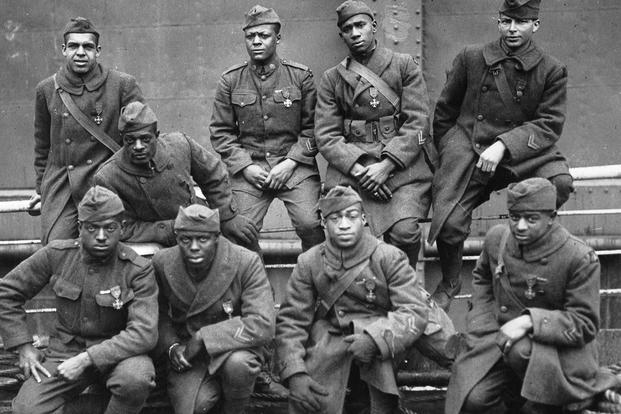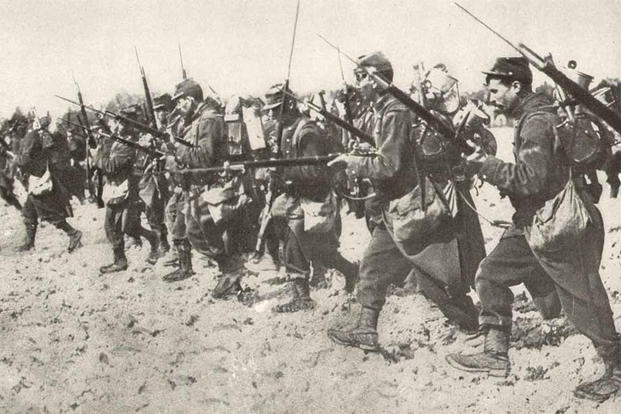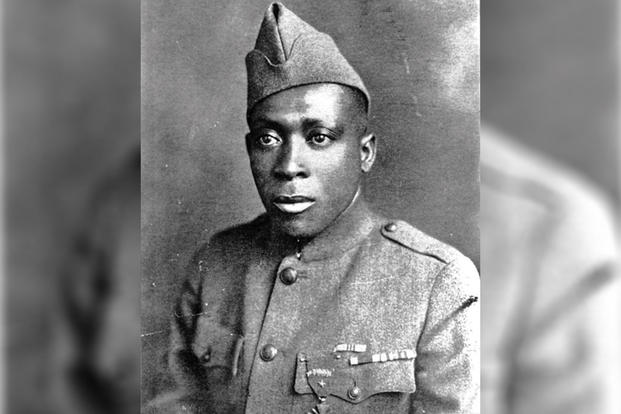Stone Cold
Superstar

Though their actions didn’t immediately alter the fight for equal rights at home, the regiment’s wartime service heightened a sense that sending African-Americans to fight for democracy abroad — while racial segregation and inequality went unchecked at home — smacked of hypocrisy.
Here are five stories of bravado and courage from the 369th — the first U.S. regiment to cross into Germany over the Rhine River, and one of the most decorated American units of the war.
1. Even the Harlem Hellfighters’ rifles were segregated.

A remarkable photograph of an actual bayonet charge by French soldiers typical of the gallantry and spirit they display in action.
By the time the United States joined the war, its allies were in desperate need of reinforcement. The men of the 369th were sent to assist the French Army’s 16th Division on the Western Front in spring 1918. It was a strategic necessity — the Western Front desperately needed reinforcement — but it was also motivated by racial bias: Many white American soldiers refused to fight alongside their black counterparts.
The decision to hand off command of the 369th to the French started with some small-arms complications. After the regiment’s limited combat training stateside, they were issued Springfield rifles, which they had to give back after being assigned to the French, along with “almost every bit of American gear” they had — including helmets, Army greens, and food rations, according to author Stephen L. Harris’ book, “Harlem’s Hell Fighters.”
In place of their Springfields, the 369th received the French Lebel rifle — which had a reputation for reliability, but was temperamental and annoying to load. Some members of the regiment, like Capt. Hamilton Fish, saw the exchange as a bit of a disappointment.
“Their Lebels were nowhere near as good as our Springfields,” Fish said in Harris’ account. “The French, you see, were great believers in the hand grenade — their rifles seemed more or less something to put a bayonet on.”
2. That’s okay: The Hellfighters had “Black Death” and bolo knives.

Henry Lincoln Johnson in uniform, circa 1917 (U.S. Army)
While standing watch in the Argonne Forest in May 1918, two 369th soldiers, Pvt. Henry Johnson and Pvt. Needham Roberts, were attacked by a 12-man German raiding party. Outnumbered and under fire, the two men fought off the initial attack, but after Roberts was badly wounded. Johnson remained with the injured soldier to keep him from being taken prisoner by the Germans.
Wounded, advancing on the enemy with only a bolo knife, Johnson killed one German soldier by stabbing him in the head and forced the survivors to retreat. Johnson’s actions earned him national acclaim, as well as the incredibly metal nickname “Black Death.” (Eat your heart out, “Bear Jew.”)
Johnson and Roberts were among the first Americans to be presented the Croix de Guerre for valor by the French military. And in 2015, Johnson became the second African-American to receive the Medal of Honor for actions during World War I, presented by President Barack Obama during a posthumous award ceremony at the White House.
Continue -
Untold Stories Of The Harlem Hellfighters Of World War I